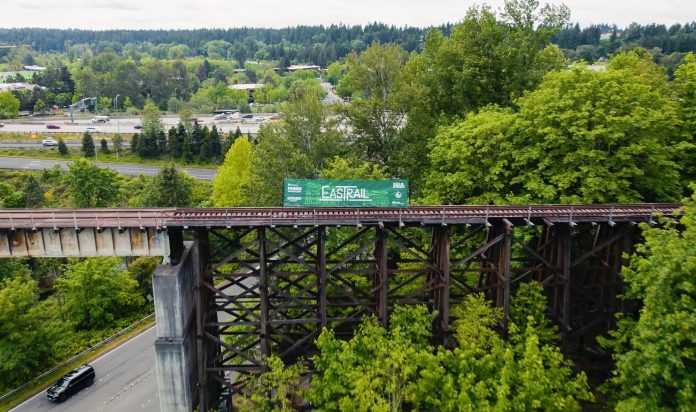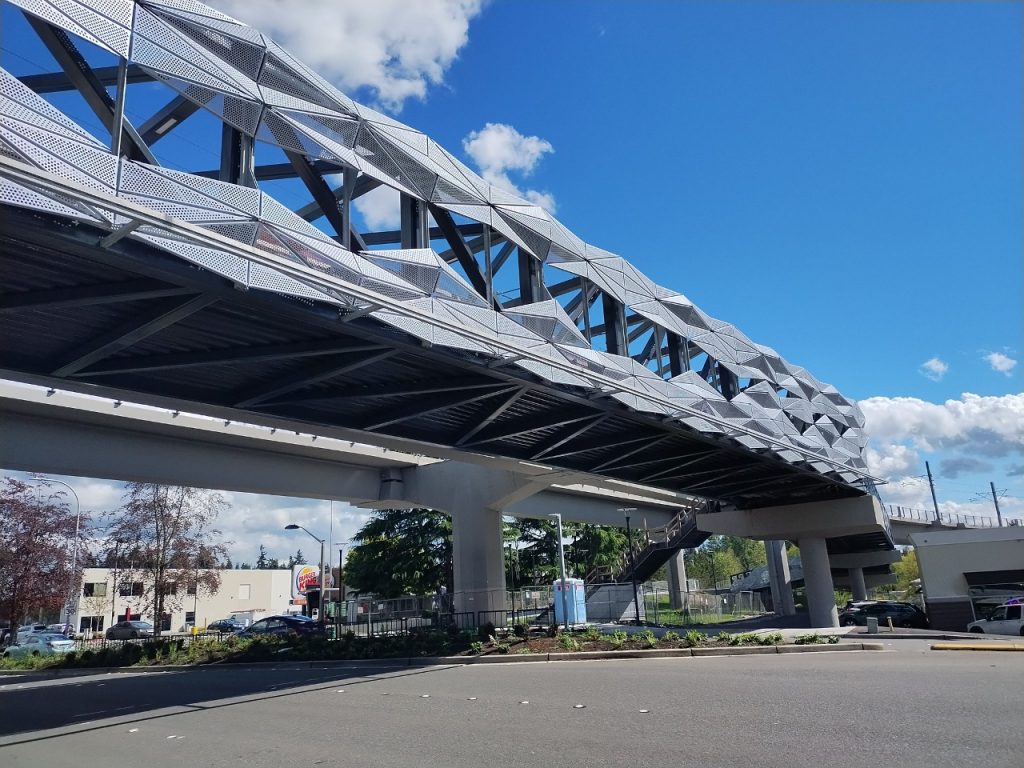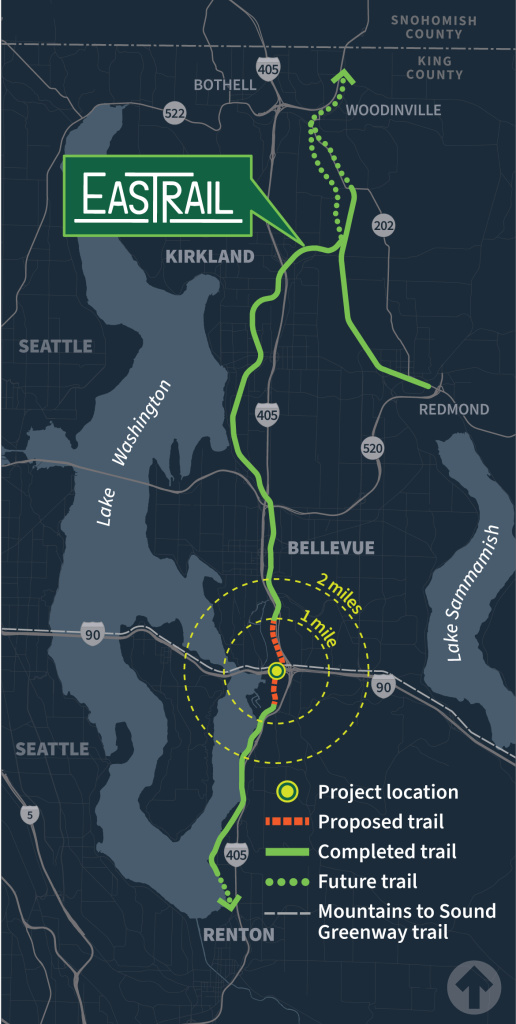
Last week, King County celebrated the start of construction on a $37 million project to upgrade Bellevue’s Wilburton Trestle and create one of the most pivotal and scenic spans of the Eastrail. The walking and biking trail will ultimately stretch 42 miles between Renton and Woodinville, and the trestle is right in the middle of this highly anticipated new Eastside connection.
The overhaul of the 1904 railroad bridge has been years in the making, and is primarily funded via the county’s 2019 parks levy. The project is also receiving funding from the State of Washington, the City of Bellevue, and private donors including Amazon and Kaiser Permanente.

When the Wilburton Trestle opens in 2026, trail users will be able to travel approximately 100 feet above Kelsey Creek along an 18-foot-wide trail. Viewing platforms facing both east and west will allow travelers to stop and enjoy the vistas without impeding the flow of traffic. Paired together with a trail bridge under construction over I-405 as part of a state freeway widening project, the trestle’s completion will be a big step toward the full 42-mile trail.
State and local leaders are touting the $9 million state portion of the funding for the Wilburton Trestle, which includes $6 million in Climate Commitment Act (CCA) dollars, as a prime example of the type of investments that would be defunded if voters ultimately approve Initiative 2117, which would repeal the CCA. Passage of the conservative-backed ballot measure would cease all future allocation of CCA funding, blowing a huge hole in the state’s transportation budget. CCA dollars are specifically earmarked for projects intended to reduce carbon emissions, with Eastrail representing a prime opportunity to create new multimodal connections where they either don’t currently exist or are incredibly unpleasant to make.
“The Wilburton Trestle segment of the Eastrail will be one of the most breathtaking stretches of trail in King County. It will also play a vital role in connecting our region, giving Eastside residents more options to travel on foot or by bike — healthier choices for people and our environment,” King County Councilmember Claudia Balducci said in a statement following last Friday’s event. “Thank you to our partners like Amazon and Kaiser Permanente for investing in our community, to the state for putting Climate Commitment Act dollars to work on the Eastside, and especially to Executive Constantine for his leadership and vision in bringing this project to fruition. I look forward to the day we can all enjoy a walk or ride along this beautiful and critical Eastrail segment!”
The original Wilburton train trestle was rebuilt four times, in 1913, 1924, 1934, and 1943, as the timber deteriorated. As recently as 2007, it still carried passenger trains, with the Spirit of Washington Dinner Train offering a 3.5 hour trip from Renton to Woodinville and back six days a week. In 2008, BNSF railway ran its last freight train carrying Boeing fuselages from Snohomish to Renton, abandoning the line and creating an opening for the county to purchase it.
A sizable continent of Eastside residents didn’t want to see the trestle converted to a rail trail, instead pushing for passenger rail service on the corridor, with the “Eastside Rail Now!” campaign website still active to this day. But the debate over continuing to use the corridor for rail was largely put to bed in 2008, when a rail tunnel providing a way across I-405 was demolished as part of a highway project.

On June 23, the county will open the NE 8th Street overcrossing, which connects directly to Sound Transit’s Wilburton Station, providing a grade separated way to cross over the busy arterial street, and unlocking the next short segment of Eastrail south toward NE 4th Street. The opening of Eastrail segments in stages continues to unlock multimodal connections, especially as the 2 Line now provides additional light rail access between Redmond and Bellevue.

Now that the Wilburton Trestle is under construction, the last major piece of Eastrail in Bellevue that remains unfunded is a planned steel bridge connection over I-90. This year, King County requested $25 million from the US Department of Transportation (USDOT) to get the project almost fully funded, with a $10 million gap left to fill. But even if the funding gap is closed, the I-90 bridge wouldn’t be set to open until after 2030. In the meantime, the trail will connect users to 118th Avenue SE bike lanes near Mercer Slough, where they can cross under I-90.

Meanwhile, at the north end of Eastrail, work is now getting underway to extend the corridor through Woodinville, ultimately connecting into Snohomish County and the Centennial Trail.
King County is just starting the process of examining what projects might be in the next version of the county parks levy, which is up for renewal in 2025. Trail connections around Renton, finally stitching together the last segments of Eastrail, the Cedar River Trail, and the Lake to Sound Trail, are expected to be an area of focus as the county tries to maximize the value of its trail investments and create the greatest number of connections.
Ryan Packer has been writing for The Urbanist since 2015, and currently reports full-time as Contributing Editor. Their beats are transportation, land use, public space, traffic safety, and obscure community meetings. Packer has also reported for other regional outlets including Capitol Hill Seattle, BikePortland, Seattle Met, and PubliCola. They live in the Capitol Hill neighborhood of Seattle.


